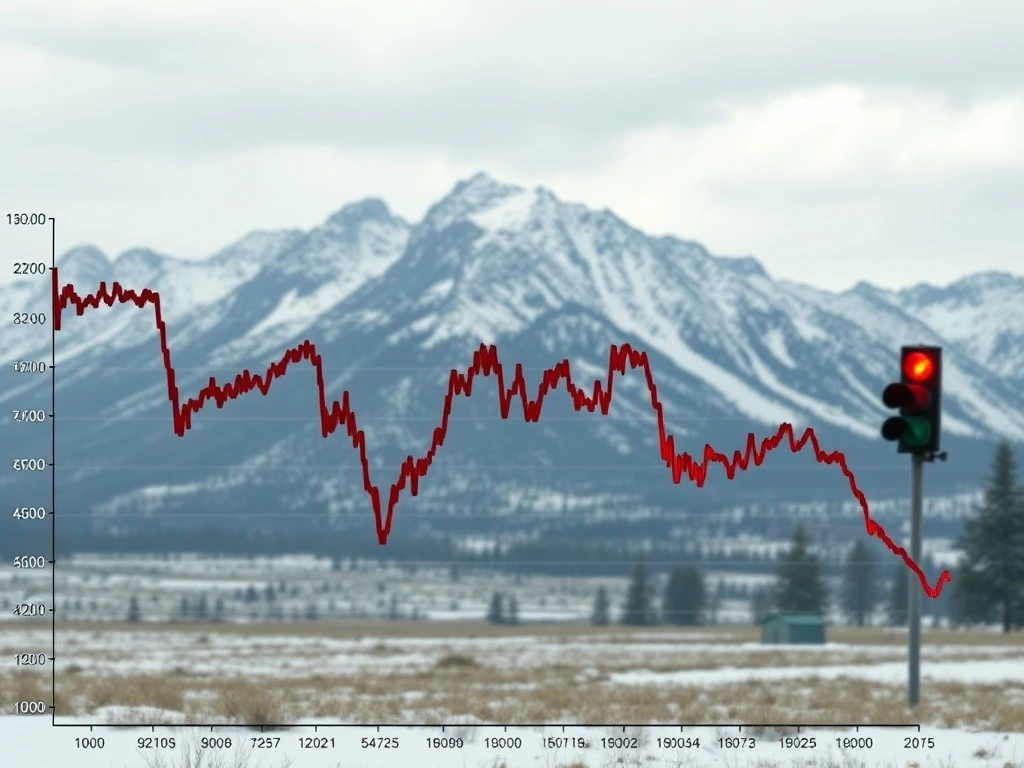The specter of a significant stock market decline looms over investors this fall. One strategist warns of a potential 15% slide, emphasizing a critical signal from the upcoming Jackson Hole Economic Symposium. This annual gathering of central bankers and economists often sets the tone for future monetary policy. Therefore, market participants keenly await any pronouncements. Without a clear message, however, the markets could face considerable headwinds.
Understanding the Jackson Hole Economic Symposium
Investors often focus intently on the Jackson Hole Economic Symposium. It serves as a pivotal event for global financial markets. Hosted annually by the Federal Reserve Bank of Kansas City, the symposium brings together central bankers, finance ministers, academics, and financial market participants from around the world. Participants discuss long-term policy issues. Historically, key policy shifts or significant insights into monetary policy have emerged from this event. For example, former Federal Reserve Chair Ben Bernanke used the 2010 symposium to signal the possibility of a second round of quantitative easing. This announcement significantly impacted market expectations. Consequently, any perceived lack of clarity or a hawkish stance could easily trigger market apprehension, potentially accelerating a stock market decline.
The Strategist’s Warning: A Missing Signal for Stock Market Decline
The strategist’s cautionary outlook hinges on a specific missing signal. They suggest that without a clear indication of the Federal Reserve’s future policy path, particularly regarding interest rates and inflation control, market uncertainty will intensify. This lack of guidance could easily translate into a 15% stock market decline during the autumn months. The strategist implies that markets require reassurance. Specifically, investors seek clarity on the Fed’s commitment to price stability while also managing economic growth. If the Fed’s communication appears ambiguous or suggests a prolonged period of high rates, this could undermine investor confidence. Therefore, the absence of a definitive ‘all-clear’ signal is a primary concern. Furthermore, this ambiguity might prompt investors to de-risk their portfolios.
Factors Fueling Potential Market Vulnerability
Several factors contribute to the market’s current vulnerability.
- Persistent inflation remains a significant worry. Although inflation has shown signs of moderating, it still sits above the Fed’s 2% target.
- The ongoing tightening of monetary policy, with higher interest rates, continues to weigh on corporate earnings and consumer spending. Higher borrowing costs impact businesses.
- Global economic slowdown concerns are growing. Major economies face challenges, impacting export-driven sectors.
- Geopolitical tensions add another layer of uncertainty. Events abroad can quickly spill over into financial markets.
Together, these elements create a fragile environment. Consequently, any negative catalyst, such as a perceived policy misstep from Jackson Hole, could accelerate a stock market decline.
Historical Precedents and Market Reactions
History offers insights into how markets react to central bank signals. Past Jackson Hole symposiums have indeed provided crucial turning points. For instance, strong signals about future rate hikes or quantitative tightening have historically led to market volatility. Conversely, dovish signals have often spurred rallies. Consider the taper tantrum of 2013. While not directly from Jackson Hole, it highlighted market sensitivity to Fed communication about asset purchases. Investors quickly reacted to perceived shifts in policy. Thus, the market’s current anticipation reflects this historical pattern. A clear, reassuring message could prevent a severe stock market decline. However, an ambiguous or unexpectedly hawkish tone could trigger rapid sell-offs.
Navigating the Autumn Outlook: Investor Considerations
As autumn approaches, investors face a critical period. Monitoring the Jackson Hole symposium’s outcomes is paramount. Consider these steps:
- Pay close attention to any statements regarding inflation targets, interest rate projections, and the overall economic outlook.
- Assess your portfolio’s exposure to interest-rate sensitive sectors. Companies with high debt loads might face increased pressure.
- Diversify your investments across different asset classes. Cash reserves can provide flexibility during volatile periods.
- Maintain a long-term perspective. This often helps weather short-term fluctuations.
Remember, market corrections are a normal part of economic cycles. Preparing for potential downside risks, including a stock market decline, allows for more informed decision-making.
Conclusion
The upcoming Jackson Hole Economic Symposium carries significant weight for the financial markets. One strategist’s warning of a potential 15% stock market decline underscores the need for clear communication from central bankers. Without a definitive signal, uncertainty could prevail, leading to market turbulence. Investors should remain vigilant, carefully analyzing the outcomes of the symposium and adjusting their strategies as needed. Prudent planning can help mitigate risks in an evolving economic landscape.
Frequently Asked Questions (FAQs)
1. What is the Jackson Hole Economic Symposium?
The Jackson Hole Economic Symposium is an annual conference hosted by the Federal Reserve Bank of Kansas City. It brings together central bankers, finance ministers, academics, and financial market participants to discuss economic issues and monetary policy.
2. Why is the Jackson Hole signal so important for the stock market?
The symposium often provides insights into future monetary policy directions, particularly from the Federal Reserve. Clear signals can reassure markets, while ambiguity or unexpected hawkishness can trigger uncertainty and potentially lead to a stock market decline.
3. What specific signal is the strategist looking for to prevent a 15% stock market decline?
The strategist is looking for clear guidance from the Federal Reserve regarding its future policy path, especially concerning interest rates and inflation control. A lack of such clarity could intensify market uncertainty.
4. What factors could contribute to a stock market decline this fall?
Persistent inflation, ongoing monetary policy tightening, growing global economic slowdown concerns, and geopolitical tensions are all factors that could contribute to market vulnerability and a potential stock market decline.
5. How can investors prepare for potential market volatility?
Investors can prepare by monitoring the Jackson Hole outcomes, assessing portfolio exposure, diversifying investments, considering cash reserves, and maintaining a long-term perspective.
















